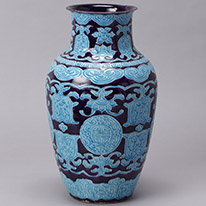Past Exhibitions
- Feature Exhibition; Hidden Treasures from a Merchant’s Storehouse:
The Hiromi Collection, a Legacy of Elegant Living
Part III: Banquets - February 3, 2018 - March 18, 2018
The Hiromi family is an old merchant family in the city of Kaizuka, in Osaka (not far from Kansai Airport). Their family business, established in 1835, was a shipping brokerage (kaisen don'ya) for the rice trade. Thereafter, they added a variety of other divisions including fertilizer, stock investment, and bank management, which not only grew the family assets but also contributed to the development of modern industry in the region. Their spacious estate includes a 34 meter-wide machiya, a tea house, and four earthen storehouses (kura) filled with a vast treasure trove of artworks—painting and calligraphy, tea utensils, furnishings, and other luxurious objects. These long hidden treasures, including works by Itō Jakuchū, Shiba Kōkan, Shibata Zeshin, and others, have been discovered in recent years and donated to the Kyoto National Museum for preservation, study, and exhibition to the public.
Part III: Banquets
Another of the Hiromis' four storehouses was filled with numerous sets of lacquers and ceramics used to serve food and drink to guests at parties. What is remarkable about this assemblage is the quantity and variation of similar types of wares: full sets of trays and bowls with the same function were made at different times with a range of pattern motifs and forms, allowing the hosts to make highly personalized selections for each specific occasion or honored guest.
One example is the elaborate banquet celebrating the third-generation head of household's Golden Wedding Anniversary in 1920. For this momentous event, the family custom-ordered thirty individual lacquered tray tables with full sets of matching bowls. Each was hand-decorated with a wave motif taken from One Hundred Paintings by Kōrin, a woodblock printed book of Rinpa-style designs compiled by artist Sakai Hōitsu (1761–1828). For this auspicious gathering, they received a Chinese poem composed for the occasion by the preeminent sinologist Nagao Uzan (1864–1942). They also used a set of dozens of matched Chinese porcelain dishes that had been in the family since the Edo period.












